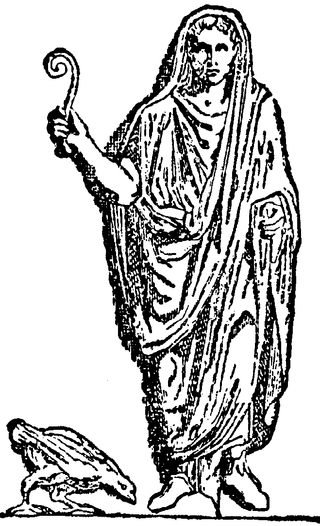
Divination is the attempt to gain insight into a question or situation by way of an occultic, standardized process or ritual. Used in various forms throughout history, diviners ascertain their interpretations of how a querent should proceed by reading signs, events, or omens, or through alleged contact or interaction with a supernatural agency.

Incense is an aromatic biotic material that releases fragrant smoke when burnt. The term is used for either the material or the aroma. Incense is used for aesthetic reasons, religious worship, aromatherapy, meditation, and ceremony. It may also be used as a simple deodorant or insect repellent.

An omen is a phenomenon that is believed to foretell the future, often signifying the advent of change. It was commonly believed in ancient times, and still believed by some today, that omens bring divine messages from the gods.

Pyromancy is the art of divination by means of fire or flames.

Frankincense is an aromatic resin used in incense and perfumes, obtained from trees of the genus Boswellia in the family Burseraceae. The word is from Old French franc encens. There are several species of Boswellia that produce true frankincense: Boswellia sacra, B. frereana, B. serrata, and B. papyrifera. Resin from each is available in various grades, which depends on the time of harvesting. The resin is hand-sorted for quality.

Augury is the practice from ancient Roman religion of interpreting omens from the observed behavior of birds. When the individual, known as the augur, interpreted these signs, it is referred to as "taking the auspices". "Auspices" literally means "looking at birds", and Latin auspex, another word for "augur", literally means "one who looks at birds". Depending upon the birds, the auspices from the gods could be favorable or unfavorable. Sometimes politically motivated augurs would fabricate unfavorable auspices in order to delay certain state functions, such as elections. Pliny the Elder attributes the invention of auspicy to Tiresias the seer of Thebes, the generic model of a seer in the Greco-Roman literary culture.

Spodomancy is a form of divination by examining cinders, soot, or ashes, particularly although not exclusively from a ritual sacrifice. Spodomancy has been practiced by numerous cultures, ancient and modern, across the globe. While many practitioners have performed the ritual as part of a formal system of paranormal, religious, or ceremonial magic, many have done so as part of mere folkloric practice or superstition.
Cowrie-shell divination refers to several distinct forms of divination using cowrie shells that are part of the rituals and religious beliefs of certain religions. Though best-documented in West Africa as well as in Afro-American religions, such as Santería, Candomblé, and Umbanda, cowrie-shell divination has also been recorded in India, East Africa, and other regions.

Alectryomancy is a form of divination in which the diviner observes a bird, several birds, or most preferably a white rooster or cockerel pecking at grain that the diviner has scattered on the ground. It was the responsibility of the pullularius to feed and keep the birds used. The observer may place grain in the shape of letters and thus discern a divinatory revelation by noting which letters the birds peck at, or the diviner may just interpret the pattern left by the birds' pecking in randomly scattered grain.

Tasseography is a divination or fortune-telling method that interprets patterns in tea leaves, coffee grounds, or wine sediments.

Oomancy refers to divination by eggs. There are several methods to how this can be done, but an example would be the oracular reading of the shapes that a separated egg white forms when dropped into hot water. This method greatly resembles molten lead divination, which ascribe meaning to the shapes and forms into which hot lead solidifies.

Scapulimancy is the practice of divination by use of scapulae or speal bones. It is most widely practiced in China and the Sinosphere, but has also been independently developed in the West.

Astragalomancy, also known as cubomancy or astragyromancy, is a form of divination that uses dice specially marked with letters or numbers.
Methods of divination can be found around the world, and many cultures practice the same methods under different names. During the Middle Ages, scholars coined terms for many of these methods—some of which had hitherto been unnamed—in Medieval Latin, very often utilizing the suffix -mantia when the art seemed more mystical and the suffix -scopia when the art seemed more scientific. Names like drimimantia, nigromantia, and horoscopia arose, along with other pseudosciences such as phrenology and physiognomy.
Religious use of incense has its origins in antiquity. The burned incense may be intended as a symbolic or sacrificial offering to various deities or spirits, or to serve as an aid in prayer.

Capnomancy is divination by examining smoke. This is done by looking at the movements of the smoke after a fire has been made. A thin, straight plume of smoke is thought to indicate a good omen whereas the opposite is thought of large plumes of smoke. If the smoke touches the ground, this is thought to be a sign that immediate action must be taken to avoid catastrophe.
Fangshi were Chinese technical specialists who flourished from the third century BCE to the fifth century CE. English translations of fangshi include alchemist, astrologer, diviner, exorcist, geomancer, doctor, magician, monk, mystic, necromancer, occultist, omenologist, physician, physiognomist, technician, technologist, thaumaturge, and wizard.

The Sandobele are members of the Sandogo, an authoritative women's society of the Senufo people, who practice divination. The Senufo inhabit the savannas and tropical rain forests of northern Côte d'Ivoire and the nearby land in Mali and Burkina Faso. The Sandogo is responsible for sustaining positive relationships with the spirit world through divination and for protecting the purity of each kinship group. The word Sandobele originates from the Senufo language.
Mesopotamian divination was divination within the Mesopotamian period.

African divination is divination practiced by cultures of Africa.















